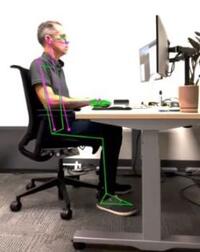 Chair Design Study
Chair Design Study
We are studying the impact of chair design on sitting behavior and usability during computer-based tasks over a prolonged bout of sitting. Participants perform word processing, web browsing and PC gaming while sitting in two different chairs for three hours each. We measure pressure distribution and sitting behavior with Tekscan pressure mats and XSens IMUs, and gather performance data for PC tasks. Subjective data about discomfort, usability and fatigue are collected with surveys.



 Evaluation of Keyboard Switch Force and Travel on Muscle Activity, Performance, and Usability
Evaluation of Keyboard Switch Force and Travel on Muscle Activity, Performance, and Usability The use of Multimodal Sensing Technologies to
The use of Multimodal Sensing Technologies to





 StandUp Kids Project
StandUp Kids Project The Implementation and Impact of Prevention Measures on the Well Being of Grocery Workers during COVID-19
The Implementation and Impact of Prevention Measures on the Well Being of Grocery Workers during COVID-19 Drill Test Bench
Drill Test Bench Concrete Dowel Drilling
Concrete Dowel Drilling The Development and Application of Exposure Assessment Devices
The Development and Application of Exposure Assessment Devices Biomechanical and Cardiovascular Strain in Hotel Room Cleaners
Biomechanical and Cardiovascular Strain in Hotel Room Cleaners Prospective studies of Carpal Tunnel Syndrome & related Work Disability
Prospective studies of Carpal Tunnel Syndrome & related Work Disability The Association Between Heavy Load Carrying and Women's Health in Developing Countries
The Association Between Heavy Load Carrying and Women's Health in Developing Countries Physical Exposures While Performing Colonoscopies
Physical Exposures While Performing Colonoscopies Dental Hygiene - Pain is NOT in the job description
Dental Hygiene - Pain is NOT in the job description Hand Computer Interaction Studies using Hand Gestures
Hand Computer Interaction Studies using Hand Gestures Tablet Design
Tablet Design Palm Rejection During Direct Touch
Palm Rejection During Direct Touch Keyboard Key Spacing
Keyboard Key Spacing Peripheral Trackpad Size
Peripheral Trackpad Size